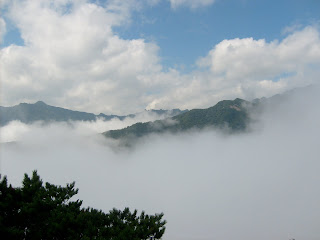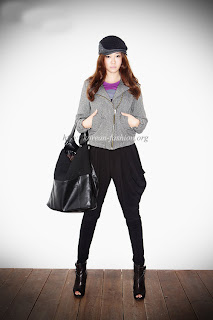So it feels strange, almost sacrilegious, to admit that I'm ready for this summer to be over. Summer is a different beast here in South Korea- a hot, humid, relentless one. In the Pacific Northwest, even a scorching hot day usually cools off at night. Not so here. It is always warm, and on bike rides home even late at night I will be dripping sweat. I literally haven't worn a pair of pants or a long sleeve shirt in months. I miss my pants.
Another reason for being ready for summer to end is the lopsided work schedule. In the summer we had a lot of "office time", aka "desk warming", aka having to be at work with not a lot to do. I tried to stay busy with productive activities, but most teachers end up painfully bored.
On the flip side, we also taught a 3-week summer camp, and I was in charge of the drama classes. We had to put on a short English play with 64 middle school students. It was an absolutely crazy 3 weeks of nonstop work. Imagine putting on a full production with that many middle school students in the U.S... then imagine it in a second language. Holy cow. Luckily my Korean co-teacher had taught drama in the past, and was an amazing source of ideas and experience. Other staff helped as well to fill in the gaps where I didn't have the time or knowledge: two teachers choreographed and taught the dances, the music teacher practiced the songs in his music classes, an intern who is going to Stanford this fall translated the whole script for the parents; a design intern painted the backdrop and made props; another intern downloaded sound clips and ran the audio. In the end, everything came together amazingly well, with many parents attending as well as the Head of the Provincial Board of Education and the Mayor of Gunsan!

Before settling in to a steady, cooler fall routine, I wanted to take one last trip. Seoraksan is a huge National Park in the northeast corner of the country. It has beautiful peaks, waterfalls, hot springs, temples, rock faces, and caves. Summer is the high season to visit, though fall is very popular also when the leaves start to change. I have gone on many smaller hikes this summer and had limited visibility in the humid air. I was really hoping for some good views, knowing that it's always a gamble with the weather. I was also really excited to "backpack" as much as is possible in Korea. As far as I can tell, there are no real "back country" wilderness areas. The national parks are large, but they will have railings along the trails and crowds even in the deepest areas. Camping and cooking and swimming are prohibited... which is good for preservation, but bad for folks who seek a less controlled mountain experience. Some parks, including Seoraksan, have shelters though. These are rustic structures with long wooden bunks, a cooking shack, and toilets, and can be reserved ahead of time. So our plans was to start in the northeast part at the Seorak-dong entrance, backpack all day up to the Jungcheongbong shelter, hike up Daecheongbong peak, then hike out the next day to Osaek to the south.

My friend Bryony and I arrived by bus in Sokcho in the northeast coast of Korea about 7 hours after leaving Gunsan, then took a city bus to Seorak-dong. We were going to camp there but it was pouring rain so we decided to check into a hotel instead. We walked up to the ranger station which had just closed for the evening, but luckily they came out to talk to us anyway. It turned out that with all the heavy rains the trail to Jungcheongbong and Daecheongbong were closed. They said maybe the trail would re-open Sunday. It was Thursday, so we definitely couldn't wait that long. This is our sad face after we realized our backpacking plans were foiled.

We were bummed, but we both kept a positive and flexible, "Let's make the best of it!" attitude. There was still a lot of hiking to do from the Seorak-dong entrance, including temples...

...a steep hike to Ulsan Bawi and decent views when the clouds parted...

... and a beautiful hike through a river valley to a cave in a high cliffside that is also a Buddhist shrine.

We also hiked to a waterfall that evening- a flat walk that felt like nothing after our steep trails of the day. We had gained over 1,400 meters of elevation (4,200 feet) that day. I woke up early the next morning not feeling sore anywhere... except my calves. We managed to hobble out to catch the bus back to Sokcho and around the park to the Osaek entrance. It hadn't rained the day before, so we were hoping the trail to Daecheongbong would be open. By the time the various bus connections got us to the trailhead, it was already noon. The ranger asked if we planned to get to the peak and back, and we said yes. He looked skeptical. "It's 8 hours roundtrip," he said. "Seven!" I countered, as though we were bargaining. "We'll be fast, we have lights, no problem!" Bryony and I assured him. We really didn't want to hike in the dark, but we had come so far to get here that we had to attempt it. We had also agreed that we could tap out anytime if we were too tired. "Where are you from?" he asked. "Mi-gook!" (America) I said. I don't know if that swayed his acceptance of our crazy plan (we didn't mention that Bryony was British) but finally he nodded and said, "Hurry".
So with calves already aching from the day before, we powered up the stone staircase of a trail. In the U.S. we would make switchbacks, but in Korea it's straight up the mountain. We barely stopped to rest as we ascended 1,000 meters (3,000 feet) in the worsening afternoon weather. It was getting cooler, foggier, and looked like rain could start any moment. We reached the top in 2 hours 45 minutes, tired but exhilarated. We were on the 3rd highest peak in Korea and couldn't see a thing!

It began raining on the descent. We hoped the same ranger would be at the trailhead when we returned so we could gloat over our triumphant 5:20 time, but it was all new faces. We managed to catch the last bus back to Seoul, buying our ticket at a tiny ticket office which was also a convenience store. The ajumma let us change clothes in her back room before settling into the bus dry, exhausted, and happy.



























